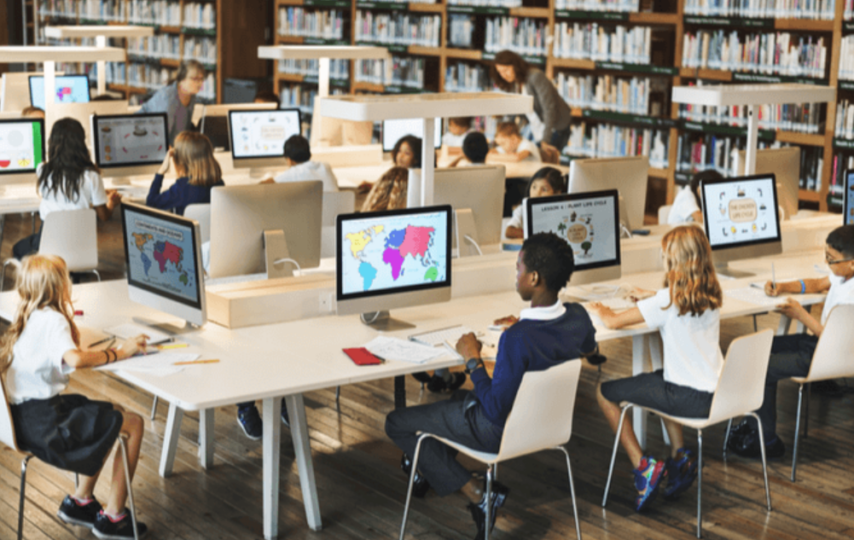Technology has taken over virtually all aspects of people’s lives. For example, most people search for products they need online before purchasing them. It has led to the development of many online stores, including eBay and Amazon. Also, people have now embraced complex technological devices, including smartphones and tablets, to stream entertaining videos.
However, most parents are often skeptical when it comes to the idea of the use of technology in classrooms. For instance, smartphones are often associated with their distracting qualities – parents feel using phones in classrooms can prevent students from focusing on their academic work. Other issues associated with using technological equipment by students include cyberbullying and social media addiction.
Technology doesn’t have to be that bad for education. The right implementation strategies have helped smoothen many education processes – teaching, revising, grading tests, tracking students’ performance, and more. And as more advancements are made, the more learning becomes easy and efficient. So let’s delve further into how tech eases education.
Access to Vast Educational Information
At each level of education, students have a lot to learn. For instance, in a business management course, a student learns about organizational behavior, management theories, and financial management concepts. An instructor issues assignments to assess the tutees’ understanding of the concepts learned. In the past, completing assignments was cumbersome and time-consuming as students had to go to the physical library. It meant they spent a lot of time scouring through the library databases to get information to help back up their ideas in their papers.
Students no longer struggle to search the library for information; they can research from their couches. Using digital libraries, students can read volumes of content on the topics they are supposed to handle. They can access journals, books, and other relevant educational materials.
Also, tutees can watch educational videos explaining those difficult course concepts. For instance, a statistics student can watch tutorials on how to use statistical packages like STATA and SPSS. That makes learning easy.
Smoothens the Process of Communication
Communication is a critical part of the education process. For example, teachers want to know if students understand course concepts. Besides, it should be easy for students to seek clarification if they don’t understand any part of the coursework.
Technological tools have made it easy for instructors to give projects to students from wherever they are. Students can then submit these tasks and receive feedback in real time. They can also seek clarification on what is expected of them. The smooth and quick communication process improves educational outcomes.
Also, it’s easy for students to communicate with each other using devices such as smartphones and applications such as Skype. This improved communication enables them to offer and receive academic assistance from their colleagues whenever necessary.
Improves Access to Education Through Virtual Learning
In the past, getting a college degree meant attending a physical classroom. It was costly in terms of money and time. People with tight schedules found acquiring the college degrees they yearned for challenging.
However, that’s a thing of the past with the current technological advancement. You can now enroll in pure online classes. That enables you to learn at your convenience – you can choose a schedule that suits you and learn from wherever you are. Simply put, technology has made it easy for people who couldn’t previously access education to do so.
Helps Acquire Crucial Soft Skills
The job market does not only require technical skills – you also need soft skills for you to become more competitive. Technology enables teachers to foster teamwork among students by issuing group projects. Students can then share ideas, communicate with each other, and share materials. This collaboration is crucial even in the workplace after the students graduate.
Also, students learn to adapt to the changes in the technological world. Technology keeps changing, and students must acknowledge that. For instance, most sectors of the economy are now adopting artificial intelligence. Tutees should learn such aspects early and adapt to those changes.
Moreover, students can learn about personal responsibility early. For instance, they can know that some aspects of technology are detrimental to the learning process. Thus, they can focus on the positives and minimize the negative impacts of technology in education and other processes.
Injects Fun Into the Learning Process
Like an essay writer at domyessay.org spices up an essay about humor with puns and jokes, tech adds some fun to learning. The learning process shouldn’t be boring for students. For example, young school kids have a short concentration span, and they need some fun in the learning process. It helps them focus and grasp the concepts instructors teach them.
Fortunately, technology can inject fun into the learning process in various ways. For example, teachers can incorporate fun quizzes and puzzles as they explain concepts to students. Besides, tutees can learn about modern issues like coding and virtual reality easily using 3D demonstrations. Consequently, educational outcomes improve.
Students also become more creative as they use technological devices. For instance, they can create models using the devices at their disposal. It becomes easier for them to apply this creativity in future work endeavors.
Enables Students in Different Locations to Share Ideas
With the application of technology in classrooms, students can learn about what’s happening in other parts of the world. For instance, students learning the German language can talk to those who use it as a first language in Germany through virtual exchange programs. That also helps them to learn about other cultures and appreciate them. Thus, technology in education creates global citizens.
Closedown
Technology positively impacts education when implemented correctly – choosing the right technologies and providing the requisite supportive resources. The goodies it adds to learning are numerous. It enables students to access vast educational content, makes educational collaboration easy, adds fun to the learning process, and enables tutees to acquire crucial soft skills. Moreover, it enhances access to education. And since innovations emerge every other day, we expect to experience even more tremendous positive impacts of tech on learning.








